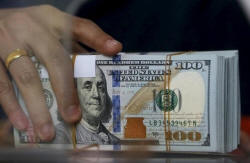|
'Helicopter money' might
weaken currencies more than QE as sky's the limit
 Send a link to a friend
Send a link to a friend
 [July 28, 2016]
By Patrick Graham [July 28, 2016]
By Patrick Graham
LONDON (Reuters) - Central banks might
inject no more cash into economies by dropping money from aircraft
-- whether real or imaginary -- than via well-worn QE schemes, but
in breaking a long-standing taboo they may do far more damage to
currencies.
After decades of zero interest rates and quantitative easing-style
asset purchases, Japan is still mired in deflation.
As the country gears up for yet more stimulus, financial market
speculation has swirled that the Bank of Japan may now go one step
further and, by introducing direct funding of government with
newly-minted notes, cross into the realm of 'helicopter money'.
The BOJ, holding a two-day policy review that ends on Friday,
insists such monetary financing is illegal.
But the yen has tossed and turned regardless, its overnight
volatility <JPYSWO=> reaching levels only seen twice in the past
quarter century - in 2008 and the Asian crisis of 1998.
One focus of the speculation has been on a scenario whereby the BOJ
would match new public spending by buying government bonds with
perpetual maturities at negligible interest rates that the state
would, in effect, never pay back.

The question for the rest of the world is whether the BOJ's dilemma
is the future for all major central banks as the world economy
stagnates and Japan's demographic of an aging population gradually
spreads to other developed nations.
Currency traders, meanwhile, are debating how - if at all - dropping
money from the sky differs from QE.
For many, breaking the policy taboo is more significant than any
quantifiable cash impact, offering a powerful restatement of the
'whatever it takes' approach and an answer to anxiety about central
banks being out of ammunition.
"It is a move to a world where central bank independence is de facto
dead and where we have crossed the Rubicon," said Javier Corominas,
head of economic research at $53 billion currency fund Record in
London.
"If we do that it will just show that the scale of the problem is
huge. At that stage why not monetize everything?"
THE BERNANKE FACTOR
The yen's spikes of the past month can be linked to reports of
meetings between Prime Minister Shinzo Abe and former Federal
Reserve chief Ben Bernanke, famously an advocate of the helicopter
drop theorized by monetarist Milton Friedman in the 1960s as an
antidote to deflation.
"Markets were reacting to the formality of it, to Japan throwing in
the towel and just agreeing to finance new debt with the creation of
new money," says Derek Halpenny, head of global market research at
Bank of Tokyo-Mitsubishi UFJ in London.
"That's the reason why longer term I can't see anything but a weaker
yen."

[to top of second column] |

An employee of a money changer holds a stack of U.S. Dollar notes
before giving it to a customer in Jakarta, October 8, 2015. REUTERS/Beawiharta

Helicopter money should be a non-starter because most central banks
are either explicitly or implicitly banned from direct monetary
financing.
Such a ban forms the centerpiece of the European Central Bank's constitution -
but circumstances change.
Just five years ago German politicians and the Bundesbank insisted the ECB could
not and would not buy government bonds but, as it ran out of other ways to
stimulate growth, legal and political resistance to QE evaporated.
"You could argue that there is some kind of soft form of helicopter money going
on anyway," says Halpenny. "There's a very fine line between monetary policy for
policy purposes and for impacting the debt levels."
To sustainably weaken its currency, then, a country may have to enter what
Pictet Asset Management strategists have dubbed "credible irresponsibility".
The problem is that if everyone prints, it becomes a zero-sum game for the
foreign exchanges - not unlike the parallel rounds of QE in recent years.
Despite Japan leading the way, the yen is just as strong now as it was in late
2008.
The other big risk is the cure becoming worse than the disease.
Global bond investor PIMCO said that since the 18th century there have been 56
examples of direct monetary financing, from France in 1795 to Zimbabwe in 2007.
All had dire economic consequences.
Dropping cash directly onto consumers may well be the end of that line and, if
that fails to work, governments may be very reluctant to reinstate monetary
financing bans in future - creating the threat of systemic collapse.

"The main difference between helicopter and other possibilities, lies in the
credibility of the whole monetary system," Swiss economist Reto Foellmi told a
discussion on Reuters Global Markets Forum this week. "If helicopter money is
done literally, they would cross a point of no return."
(Additional reporting by Patrick Graham; editing by John Stonestreet)
[© 2016 Thomson Reuters. All rights
reserved.] Copyright 2016 Reuters. All rights reserved. This material may not be published,
broadcast, rewritten or redistributed. |